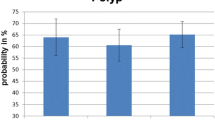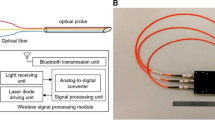Abstract
Purpose
Optical image enhancement techniques are widely used in endoscopy to improve the visualization of blood vessels for diagnostic and therapeutic purposes. These techniques are monitor-based and therefore not available for direct microscopy. In this study, a novel optical microscope filter, Hemoglobin absorption spectral imaging (H.A.S.I.) was tested for use in microlaryngoscopy.
Methods
A novel dichroic filter was designed to improve contrast in small blood vessels by highlighting transmission in the spectrum range of hemoglobin absorption maxima. A surgical microscope equipped with the novel H.A.S.I. filter was installed in one operating room in our institution. 68 consecutive patients referred to our ENT department for endoscopy were examined using white light and the novel H.A.S.I. filter during microlaryngoscopy. Surgeons described the blood vessels of the vocal cords using a classification chart and assessed for suspected malignancy using both white light and H.A.S.I.
Results
77 consecutive microlaryngoscopies were performed on 68 patients. 142 vocal cords were visualized in microlaryngoscopy and the blood vessels classified according to the chart. With white light, 152 blood vessel characteristics were documented and 157 with H.A.S.I. Notably, pathologies like benign horizontal blood vessel changes, leukoplakia, and vertical blood vessel changes like dots and loops were seen more frequently with H.A.S.I. Finally, seven lesions were treated by transoral laser microsurgery (TLM) with H.A.S.I. to test the practicability of the method for microlaryngoscopic laser surgery.
Conclusion
This is the first study describing H.A.S.I. as an optical staining method for microlaryngoscopy. In our experience, the method was practical and improved the evaluation of vocal cord blood vessels. In some cases, the use of H.A.S.I. led to a change in diagnosis and treatment. Also, H.A.S.I. was found to be helpful in microlaryngeal laser surgery for demarcating resection margins. This is, to our knowledge, the first optical staining method integrated into a surgical microscope and can be conveniently used during microlaryngeal laser surgery and does not require further equipment.





Similar content being viewed by others
Data availability
The surgical microscope i View 31 was provided by Atmos (ATMOS MedizinTechnik, Lenzkirch, Germany).
Code availability
Not applicable.
References
Von Leden H (1988) Microlaryngoscopy: a historical vignette. J Voice 1(4):341–346. https://doi.org/10.1016/S0892-1997(88)80009-2
Abdullah B, Rasid NSA, Lazim NM, Volgger V, Betz CS, Mohammad ZW, Hassan NFHN (2020) Ni endoscopic classification for storz professional image enhancement system (SPIES) endoscopy in the detection of upper aerodigestive tract (UADT) tumors. Sci Rep. https://doi.org/10.1038/s41598-020-64011-6
Fostiropoulos K, Arens C, Betz C, Kraft M (2016) Nichtinvasive bildgebung mittels autofluoreszenzendoskopie: stellenwert bei der früherfassung des kehlkopfkarzinoms [Noninvasive imaging using autofluorescence endoscopy: value for the early detection of laryngeal cancer]. HNO 64:13–18. https://doi.org/10.1007/s00106-015-0095-5
Gerstner AO, Laffers W, Schade G, Göke F, Martin R, Thies B (2012) Endoskopie des larynx mit hyperspectral imaging [Endoscopy of the larynx by hyperspectral imaging]. HNO 60:1047–1052. https://doi.org/10.1007/s00106-012-2632-9 (German)
Kraft M, Arens C, Betz C, Fostiropoulos K (2016) Fluoreszenzbildgebung in der laryngologie: physikalische grundlagen, klinische anwendung und studienergebnisse [Fluorescence imaging in laryngology: physical principles, clinical applications and study results]. HNO 64:4–12. https://doi.org/10.1007/s00106-015-0098-2 (German)
Kim DH, Kim Y, Kim SW, Hwang SH (2020) Use of narrowband imaging for the diagnosis and screening of laryngeal cancer: a systematic review and meta-analysis. Head Neck 42:2635–2643. https://doi.org/10.1002/hed.26186
Mehlum CS, Rosenberg T, Dyrvig AK, Groentved AM, Kjaergaard T, Godballe C (2018) Can the Ni classification of vessels predict neoplasia? A systematic review and meta-analysis. Laryngoscope 128:168–176. https://doi.org/10.1002/lary.26721
Arens C, Piazza C, Andrea M, Dikkers FG, TjonPianGi RE, Voigt-Zimmermann S, Peretti G (2016) Proposal for a descriptive guideline of vascular changes in lesions of the vocal folds by the committee on endoscopic laryngeal imaging of the European Laryngological Society. Eur Arch Otorhinolaryngol 273:1207–1214. https://doi.org/10.1007/s00405-015-3851-y
Ni XG, He S, Xu ZG, Gao L, Lu N, Yuan Z, Lai SQ, Zhang YM, Yi JL, Wang XL, Zhang L, Li XY, Wang GQ (2011) Endoscopic diagnosis of laryngeal cancer and precancerous lesions by narrow band imaging. J Laryngol Otol 125:288–296. https://doi.org/10.1017/S0022215110002033
Simo R, Bradley P, Chevalier D, Dikkers F, Eckel H, Matar N, Peretti G, Piazza C, Remacle M, Quer M (2014) European Laryngological Society: ELS recommendations for the follow-up of patients treated for laryngeal cancer. Eur Arch Otorhinolaryngol 271:2469–2479. https://doi.org/10.1007/s00405-014-2966-x
Bootz F (2020) S3-Leitlinie diagnostik, therapie und nachsorge des larynxkarzinoms [Guideline on diagnosis, treatment, and follow-up of laryngeal cancer]. HNO 68:757–762. https://doi.org/10.1007/s00106-020-00908-y (German)
Steiner W (1993) Results of curative laser microsurgery of laryngeal carcinomas. Am J Otolaryngol 14:116–121. https://doi.org/10.1016/0196-0709(93)90050-h
Canis M, Ihler F, Martin A, Wolff HA, Matthias C, Steiner W (2013) Organ preservation in T4a laryngeal cancer: is transoral laser microsurgery an option? Eur Arch Otorhinolaryngol 270:2719–2727. https://doi.org/10.1007/s00405-013-2382-7
Canis M, Ihler F, Martin A, Wolff HA, Matthias C, Steiner W (2014) Results of 226 patients with T3 laryngeal carcinoma after treatment with transoral laser microsurgery. Head Neck 36:652–659. https://doi.org/10.1002/hed.23338
Plaat BEC, Zwakenberg MA, van Zwol JG, Wedman J, van der Laan BFAM, Halmos GB, Dikkers FG (2017) Narrow-band imaging in transoral laser surgery for early glottic cancer in relation to clinical outcome. Head Neck 39:1343–1348. https://doi.org/10.1002/hed.24773
Campo F, D’aguanno V, Greco A, Ralli M, de Vincentiis M (2020) The prognostic value of adding narrow-band imaging in transoral laser microsurgery for early glottic cancer: a review. Lasers Surg Med 52:301–306. https://doi.org/10.1002/lsm.23142
Adachi K, Umezaki T, Kiyohara H, Komune S (2015) New technique for laryngomicrosurgery: narrow band imaging-assisted video-laryngomicrosurgery for laryngeal papillomatosis. J Laryngol Otol 129(Suppl2):S74–S76. https://doi.org/10.1017/S0022215114002436
Locatello LG, Maggiore G, Bruno C, Gallo O (2020) Transoral laryngeal videosurgery under the direct guidance of narrow band imaging: a preliminary report. Lasers Med Sci 35:2065–2068. https://doi.org/10.1007/s10103-020-03022-1
Bertino G, Cacciola S, Fernandes WB Jr, Fernandes CM, Occhini A, Tinelli C, Benazzo M (2015) Effectiveness of narrow band imaging in the detection of premalignant and malignant lesions of the larynx: validation of a new endoscopic clinical classification. Head Neck 37:215–222. https://doi.org/10.1002/hed.23582
Funding
The authors did not receive support from any organization for the submitted work. No funding was received to assist with the preparation of this manuscript. No funding was received for conducting this study. No funds, grants, or other support was received.
Author information
Authors and Affiliations
Contributions
All authors contributed to the study conception and design. Material preparation, data collection, and analysis were performed by AK, FG, NS, BB, and NK. The first draft of the manuscript was written by AK, and all authors commented on previous versions of the manuscript. All authors read and approved the final manuscript.
Corresponding author
Ethics declarations
Conflict of interest
The authors have no relevant financial or non-financial interests to disclose. The authors have no conflicts of interest to declare that are relevant to the content of this article. All authors certify that they have no affiliations with or involvement in any organization or entity with any financial interest or non-financial interest in the subject matter or materials discussed in this manuscript. The authors have no financial or proprietary interests in any material discussed in this article.
Ethical approval
Medical faculty Mannheim, Heidelberg University, 2021-402-§23b.
Consent to participate
Not applicable.
Consent for publication
Not applicable.
Additional information
Publisher's Note
Springer Nature remains neutral with regard to jurisdictional claims in published maps and institutional affiliations.
Rights and permissions
About this article
Cite this article
Keller, A.P., Grothe, F., Stasche, N. et al. Hemoglobin Absorption Spectral Imaging (H.A.S.I.): a novel optical staining technique for microlaryngoscopy. Eur Arch Otorhinolaryngol 279, 817–823 (2022). https://doi.org/10.1007/s00405-021-07090-z
Received:
Accepted:
Published:
Issue Date:
DOI: https://doi.org/10.1007/s00405-021-07090-z




